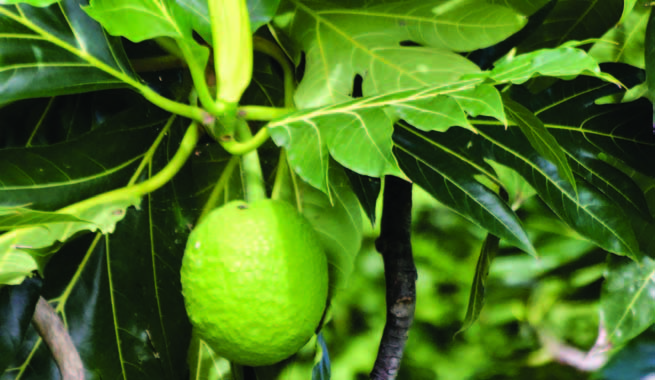Food for Thought / Journal /
Eat Bajan – Breadfruit!
A part of the Bajan food culture is to roast a breadfruit on an open fire. A breadfruit tree typically grows to a height of 80 feet producing over 150 fruits per crop and bears for 50+ years! It grows abundantly on the island and when bearing there’ll be large fruits the size of a football dotted around the tree […]

A part of the Bajan food culture is to roast a breadfruit on an open fire. A breadfruit tree typically grows to a height of 80 feet producing over 150 fruits per crop and bears for 50+ years! It grows abundantly on the island and when bearing there’ll be large fruits the size of a football dotted around the tree between its beautiful lush leaves.
The notion of importing breadfruit from Tahiti was to provide food security for the island. Land produced a higher return on investment if planted in sugar cane than in foods, but breadfruit could be planted in unproductive areas like St. John’s hills and gullies. Captain Bligh (really Lieutenant Blight at the time) was sent in 1789 to Tahiti in command of His Majesty’s Armed Vessel Bounty, a merchant ship purchased by the Royal Navy for the purpose. This was the vessel and the voyage famed in the Mutiny on the Bounty. After surviving his epic 3600-mile voyage in an open longboat, and his subsequent court martial, Captain Bligh was sent back to Tahiti as master and Commander of HMS Providence to get the breadfruit in 1793, a mission he accomplished successfully on this second attempt.
Breadfruit belongs to the Moraceae family and is related to other exotic fruits like breadnut, jackfruit, figs and mulberries. It has thick skin, outlined with many markings. These markings represent one of the key differences for a breadfruit from any other fruit. A breadfruit grows from a cluster of flowers with each flower making a mark on the skin; this is called a multiple fruit. Most fruit grows from just a single flower. The fruit itself is spongy and bread-like on the inside. In Barbados, there are two main types: yellow and white heart. The yellow has a slightly sweeter flavor and is best for roasting. The white heart is typically for boiling in soups or with other vegetables. Both types are good for frying and steaming.
Just as the name indicates, this is a fibrous starch; a cup of breadfruit provides approximately 60 grams of carbohydrates. It is also moderately high in Vitamin C, riboflavin, magnesium and potassium. It is lower on the glycemic index than potatoes.
A roasted breadfruit results in tender flesh and a slightly roasted flavor. To bake, rinse the skin, cut in half and place cut side down on an oiled baking sheet or in a shallow baking pan with 1⁄2–3⁄4 inch (1–2 cm) of water. It can also be cooked whole; wrapped in aluminum foil to keep the flesh moist. Bake at 190–2055°C for one hour or until the fruit can be easily pierced with a fork.
Once roasted the flesh can be cut into strips and marinated in your favorite flavors then put on the grill or under the broiler. An old time Bajan, Kathleen Loftfield (AKA Edghill), says Breadfruit Cou-cou is the way to use the versatile fruit. She suggests peeling and boiling it then mashing it all up with butter and some stock that it was cooked in. Use as a starch base with a difference!!! It loves gravy!
An alternative to potatoes in every way, try making your own breadfruit chips. Peel and cut into quarters and soak in salt water with a bit of turmeric added. Drain, thinly slice, fry in coconut oil and sprinkle with salt and chili powder – yum.